دانلود کتاب شبیه سازی دینامیک سیالات محاسباتی خشک کنهای پاششی Computational Fluid Dynamics Simulation of Spray Dryers
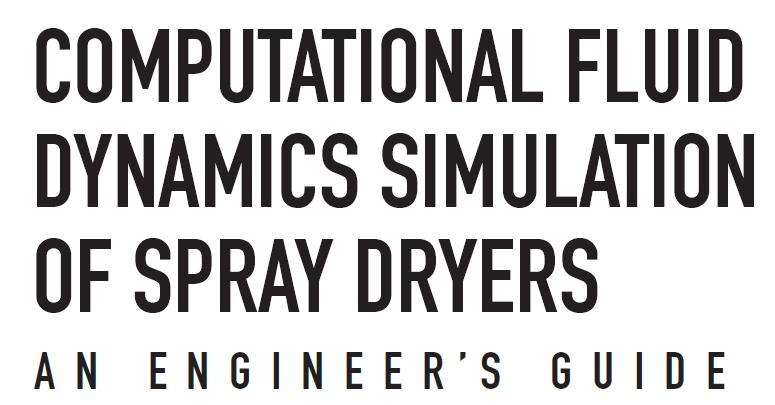
در این کتاب دربارۀ نحوۀ شبیه سازی خشک کنهای اسپری به روش دینامیک سیالات محاسباتی صحبت شده است.
دانلود مقاله مروری بر اثرات میدانهای مغناطیسی و میدانهای الکتریکی بر انتقال حرارت جوششی و شارحرارتی بحرانی(CHF) A Review on Effects of Magnetic Fields and Electric Fields on Boiling Heat Transfer and CHF
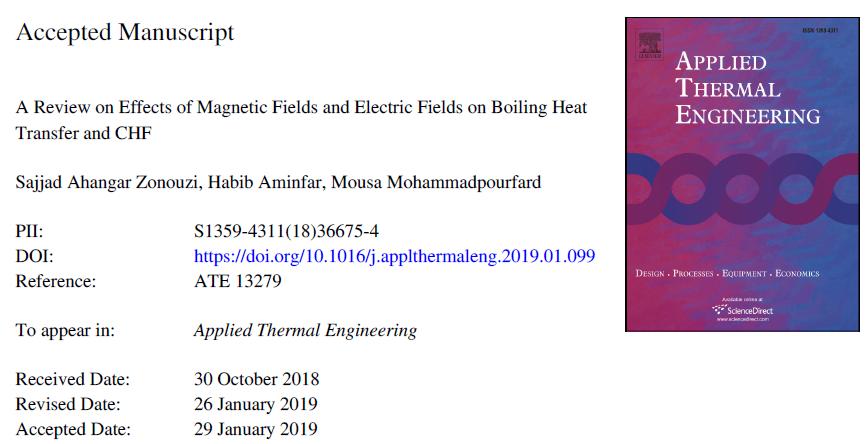
Taking advantage of electric fields and magnetic fields during boiling processes can be a very
beneficial way for enhancement of boiling heat transfer and increase of the critical heat flux
values. Applying magnetic fields and electric fields are promising active techniques which
contribute to higher heat flux accompanied by small wall superheat temperature. This paper
consist a complete review of published literature about effects of applying magnetic fields and
electric fields on heat transfer and critical heat flux during pool boiling and flow boiling
processes. The paper also includes the major affecting parameters and mechanisms reported in
the literature about the boiling heat transfer and critical heat flux in the presence of magnetic
fields and electric fields. The related achievements, results, inconsistencies and contradictions
existing in the literature are identified and discussed in detail. Some recommendations and
research directions for future studies are suggested.
دانلود مقاله مروری بر انتقال حرارت جوششی و رفتار لوله های گرمایی با سیالات دوباره مرطوب شونده (SRF)A review of boiling heat transfer and heat pipes behaviour with self-rewetting fluids
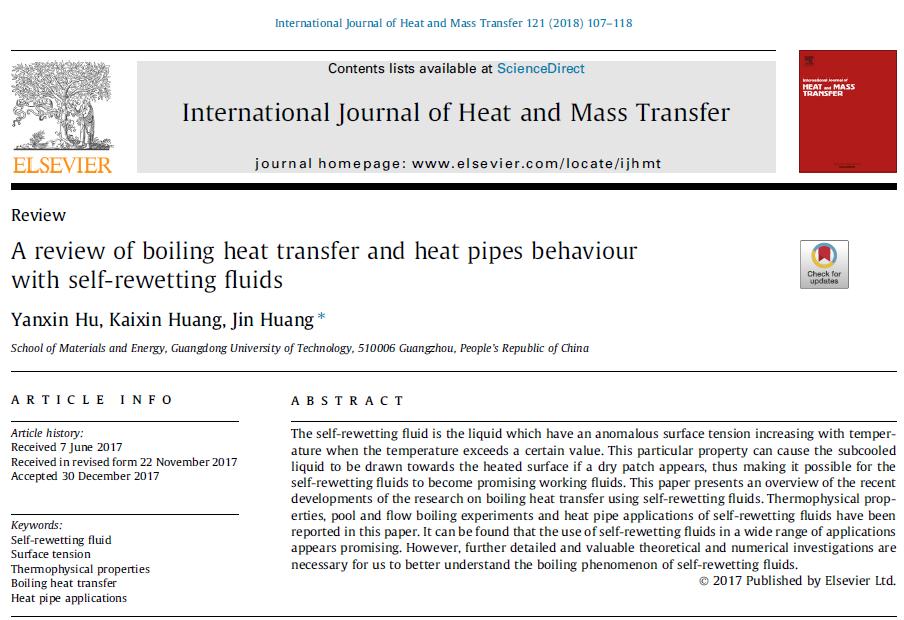
The self-rewetting fluid is the liquid which have an anomalous surface tension increasing with temperature
when the temperature exceeds a certain value. This particular property can cause the subcooled
liquid to be drawn towards the heated surface if a dry patch appears, thus making it possible for the
self-rewetting fluids to become promising working fluids. This paper presents an overview of the recent
developments of the research on boiling heat transfer using self-rewetting fluids. Thermophysical properties,
pool and flow boiling experiments and heat pipe applications of self-rewetting fluids have been
reported in this paper. It can be found that the use of self-rewetting fluids in a wide range of applications
appears promising. However, further detailed and valuable theoretical and numerical investigations are
necessary for us to better understand the boiling phenomenon of self-rewetting fluids.
دانلود مقاله مروری بر افزایش انتقال حرارت در جوشش با استفاده از مواد افزودنی/شناورسازها (سورفکتانتها)A review on augmentation of heat transfer in boiling using surfactants/additives
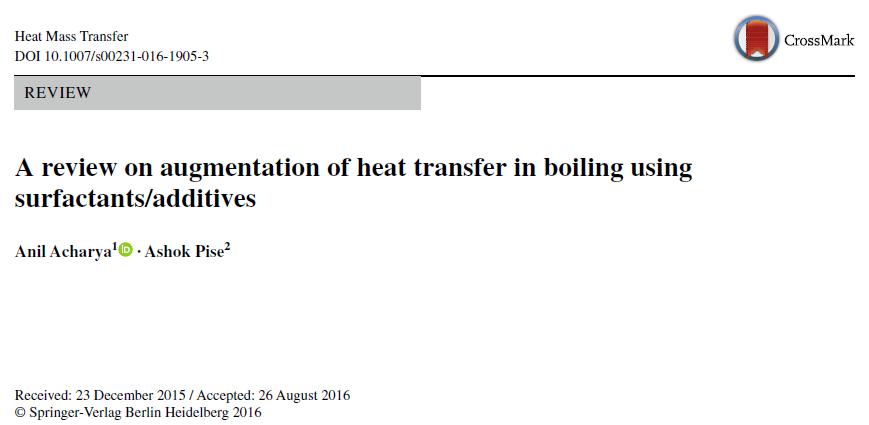
Studies of heat transfer enhancement in boiling
under various conditions and configurations have given different
results. Understanding the boiling behaviour from
these studies, literature is reviewed in terms of surface texture,
heater geometry and orientation, experimental and numerical
studies in presence of surfactant/additives. After understanding
different behaviour in boiling, the effect of environment
friendly surfactant is studied through literature review. Benchmarking
of experimental procedure is done by experimenting
and comparing some surfactants studied in literature.
دانلود مقاله مروری بر جوشش لایه ای در دماهای خیلی پایین A review of film boiling at cryogenic temperatures
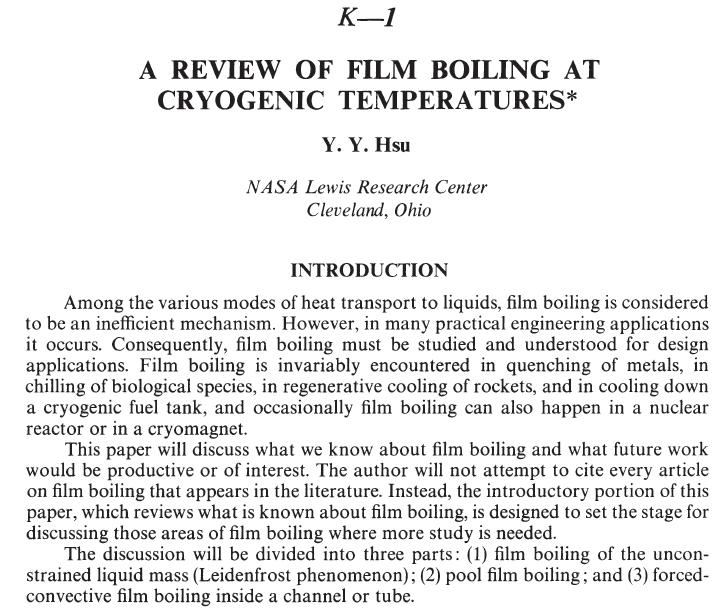
Among the various modes of heat transport to liquids, film boiling is considered
to be an inefficient mechanism. However, in many practical engineering applications
it occurs. Consequently, film boiling must be studied and understood for design
applications. Film boiling is invariably encountered in quenching of metals, in
chilling of biological species, in regenerative cooling of rockets, and in cooling down
a cryogenic fuel tank, and occasionally film boiling can also happen in a nuclear
reactor or in a cryomagnet.
This paper will discuss what we know about film boiling and what future work
would be productive or of interest. The author will not attempt to cite every article
on film boiling that appears in the literature. Instead, the introductory portion of this
paper, which reviews what is known about film boiling, is designed to set the stage for
discussing those areas of film boiling where more study is needed.
The discussion will be divided into three parts: (1) film boiling of the unconstrained
liquid mass (Leidenfrost phenomenon); (2) pool film boiling; and (3) forcedconvective
film boiling inside a channel or tube.
دانلود مقاله مروری بر مدلسازی محاسباتی جوشش جریانی در میکروکانالها A Review of Computational Modelling of Flow Boiling in Microchannels
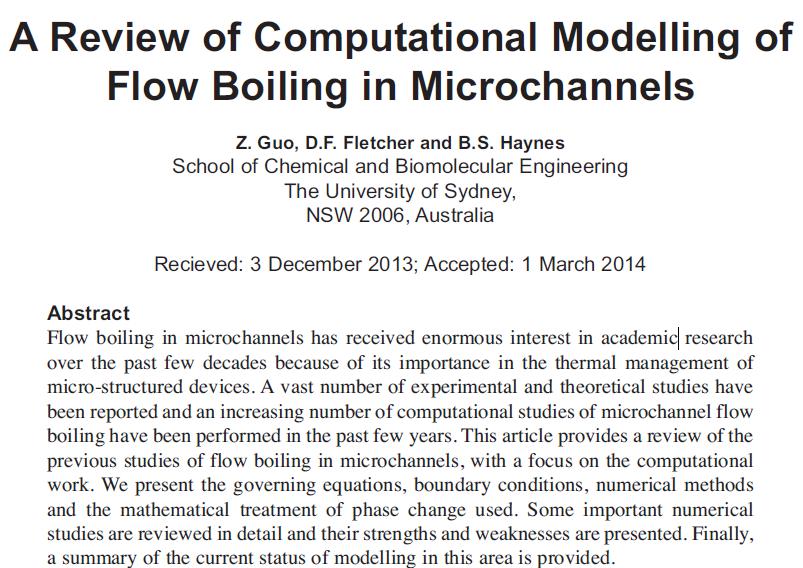
Flow boiling in microchannels has received enormous interest in academic research
over the past few decades because of its importance in the thermal management of
micro-structured devices. A vast number of experimental and theoretical studies have
been reported and an increasing number of computational studies of microchannel flow
boiling have been performed in the past few years. This article provides a review of the
previous studies of flow boiling in microchannels, with a focus on the computational
work. We present the governing equations, boundary conditions, numerical methods
and the mathematical treatment of phase change used. Some important numerical
studies are reviewed in detail and their strengths and weaknesses are presented. Finally,
a summary of the current status of modelling in this area is provided.
دانلود مقاله مروری بر مطالعه پارامتری انتقال حرارت در جوشش استخری نانوسیالها برای افزایش شار حرارتی بحرانی Parametric study of pool boiling heat transfer with nanofluids for the enhancement of critical heat flux: A review
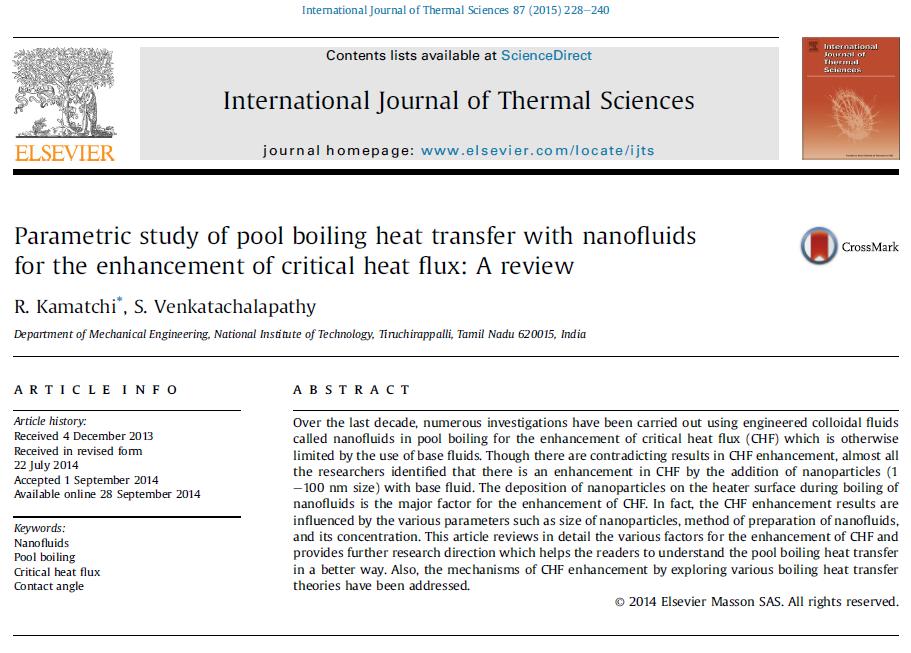
Over the last decade, numerous investigations have been carried out using engineered colloidal fluids
called nanofluids in pool boiling for the enhancement of critical heat flux (CHF) which is otherwise
limited by the use of base fluids. Though there are contradicting results in CHF enhancement, almost all
the researchers identified that there is an enhancement in CHF by the addition of nanoparticles (1
e100 nm size) with base fluid. The deposition of nanoparticles on the heater surface during boiling of
nanofluids is the major factor for the enhancement of CHF. In fact, the CHF enhancement results are
influenced by the various parameters such as size of nanoparticles, method of preparation of nanofluids,
and its concentration. This article reviews in detail the various factors for the enhancement of CHF and
provides further research direction which helps the readers to understand the pool boiling heat transfer
in a better way. Also, the mechanisms of CHF enhancement by exploring various boiling heat transfer
theories have been addressed.
دانلود مقاله مروری بر افزایش انتقال حرارت جوششی نانوسیالها و پوششهای نانو A review of enhancement of boiling heat transfer through nanofluids and nanoparticle coatings
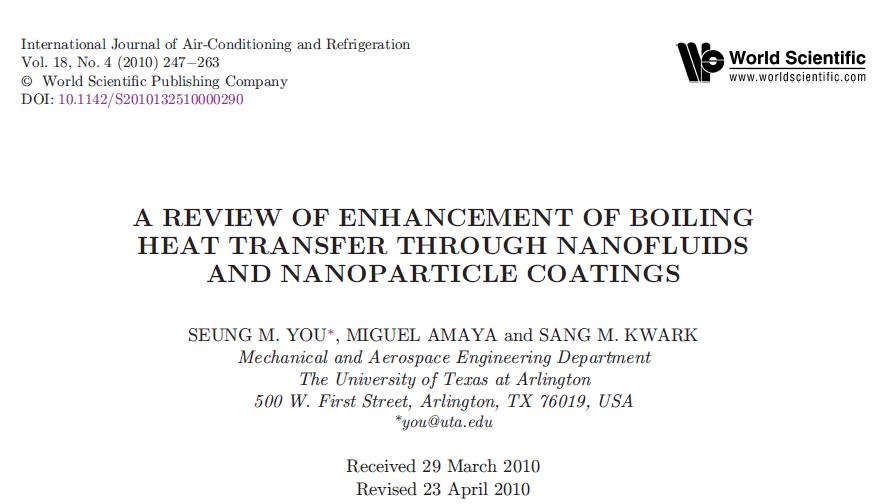
This review traces the development of nanofluid pool boiling from its beginning (1984) to the
present through a sampling of studies that have interested the authors and which have led to the
latest findings at the University of Texas at Arlington (UTA). The studies of thermophysical
properties of nanofluids are briefly covered. Several works in the last 7 years are highlighted to
illustrate the modes of nanofluid pool boiling testing, the variability of nanofluid boiling heat
transfer (BHT), and the postulations of causes of this behavior. Starting in 2006, the wettability
increase in the nanoparticle coating, generated during the nanofluid pool boiling, is recognized as
the source of critical heat flux (CHF) enhancement through its effect on the dynamics of hot spots
and departing bubbles. The reasons for the observed contradictory BHT behavior are not yet fully
clear, but recently at UTA, nanofluid boiling heat transfer has shown to be transient due to the
dynamic nature of the formation of the nanoparticle coating. Also at UTA, the mechanism of
nanoparticle deposition on the heated surface has been further confirmed. Thus, nanofluid boiling
has led back to heat transfer enhancement through surface modification in nanoscale. These
developments from 2006 are covered in more detail.
دانلود مقاله مروری بر انتقال حرارت جوششی نانو سیال ها A review of flow boiling heat transfer of nanofluids
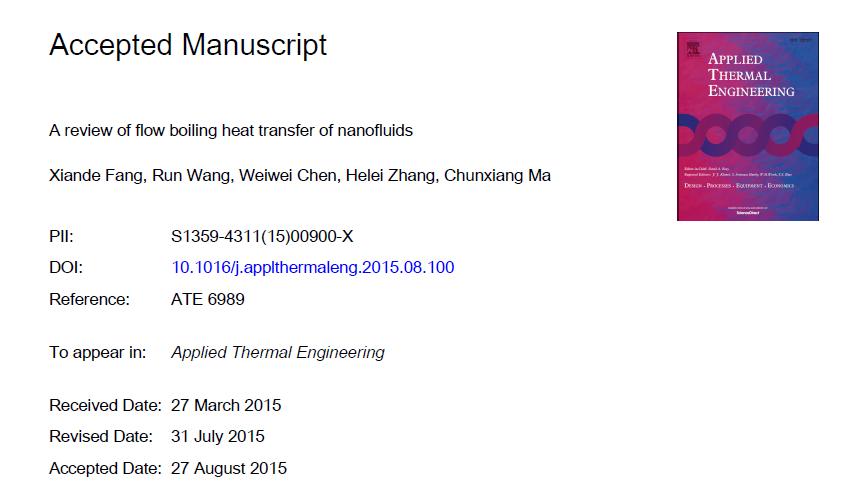
The flow boiling heat transfer of nanofluids is an important research area which provides many
opportunities to explore new frontiers but also poses great challenges. This paper presents a
comprehensive review on the flow boiling heat transfer of nanofluids, with an emphasis on the heat
transfer coefficient (HTC), critical heat flux (CHF), pressure drop, nanofluid stability, flow and heat
transfer mechanism, and flow pattern and bubble dynamics. Most of the available articles have been
related to the first four topics. Studies related to the last two topics are rare, which are reviewed
because of their importance. The important achievements, inconsistence, and contradictions of the
existing research results are identified, and several topics worthy of attention for future investigations
are identified.
دانلود مقاله مروری بر نقش سطوح حکاکی شده با لیزر روی انتقال حرارت جوششی A review on the role of laser textured surfaces on boiling heat transfer
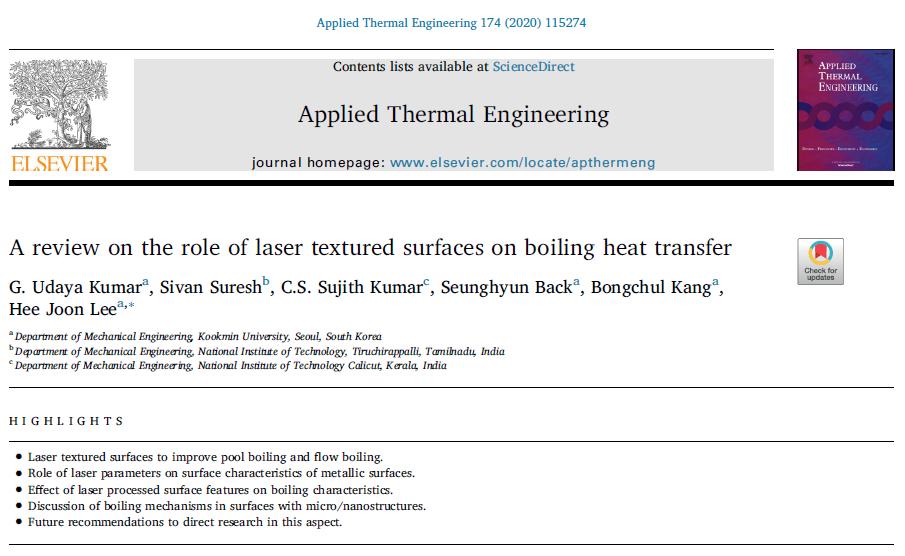
Laser texturing can effectively obtain the desired surface features on metals through melting and solidification,
or through laser-based additive manufacturing techniques. In phase-change heat transfer applications, such
modified surfaces can be both beneficial and durable. Surface modification by ultrafast processing lasers alters
the heat transfer performances of boiling systems. This review summarizes the work leading to these technologies
and their role in influencing the performance of boiling systems. It first discusses the types and material
processing mechanism of lasers. Then, the applications of laser-textured surfaces in pool boiling and flow boiling
are discussed in detail. Different types of surface patterns can be fabricated on boiling surfaces depending on
experimental requirements. It is clearly evident that the design parameters and surface characteristics like
surface roughness, surface wettability, and porosity can be easily controlled by controlling the laser parameters.
Also, heat transfer performance of the textured surfaces changes as compared to the surfaces without any texturing.
As surface features generated as a result of laser texturing are permanent, the durability of the structures
can be increased with prolonged boiling performance. The review concludes with future recommendations for
identifying the research gaps and improving the heat transfer processes by laser-textured surfaces.